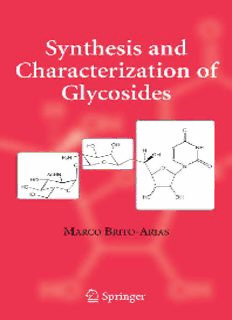
Synthesis and Characterization of Glycosides PDF
Preview Synthesis and Characterization of Glycosides
Synthesis and Characterization of Glycosides Synthesis and Characterization of Glycosides Marco Brito-Arias BiotechnologyUnit NationalPolytechnicInstituteofMexico(UPIBI-IPN) MarcoBrito-Arias BiotechnologyUnit NationalPolytechnicInstitute,Mexico laLagunaTicomaˆ Mexico LibraryofCongressControlNumber:2006927420 ISBN10:0-387-26251-2 ISBN13:978-0-387-26251-2 (cid:1)C 2007SpringerScience+BusinessMedia,LLC Allrightsreserved.Thisworkmaynotbetranslatedorcopiedinwholeorinpartwithoutthewritten permissionofthepublisher(SpringerScience+BusinessMedia,LLC,233SpringStreet,NewYork, NY10013,USA),exceptforbriefexcerptsinconnectionwithreviewsorscholarlyanalysis.Use in connection with any form of information storage and retrieval, electronic adaptation, computer software,orbysimilarordissimilarmethodologynowknownorhereafterdevelopedisforbidden. Theuseinthispublicationoftradenames,trademarks,servicemarks,andsimilarterms,evenifthey arenotidentifiedassuch,isnottobetakenasanexpressionofopinionastowhetherornottheyare subjecttoproprietaryrights. 9 8 7 6 5 4 3 2 1 springer.com ToCarminaDaniela Contents Preface................................................................................... xii 1. Glycosides,Synthesis,andCharacterization............................... 1 1.1. Introduction.................................................................. 1 1.2. ReactionsofMonosaccharides........................................... 2 1.3. ChemicalModifications................................................... 2 1.3.1. Oxidations........................................................... 3 1.3.2. PeriodateOxidation................................................ 4 1.3.3. TollensReaction.................................................... 5 1.3.4. BenedictandFehlingTest........................................ 5 1.3.5. NucleophilicAddition............................................. 6 1.3.6. EnediolRearrangement........................................... 9 1.3.7. KilianiFischerSynthesis.......................................... 9 1.3.8. TheRuffDegradation............................................. 10 1.3.9. ConversionofPentosetoFurfural............................... 10 1.4. BiosynthesisofSugars..................................................... 11 1.4.1. SugarsasEnergySources......................................... 11 1.5. SynthesisofCarbohydrates............................................... 12 1.5.1. ChemicalSynthesis................................................ 12 1.5.2. C-GlycosylAminoAcids......................................... 16 1.5.3. EnzymaticSynthesis............................................... 21 1.5.4. ChemoenzymaticSynthesis...................................... 23 1.6. SynthesisofCarbohydratesMimetics................................... 25 1.6.1. Iminosugars ......................................................... 25 1.6.2. Aminosugars........................................................ 29 1.6.3. ThiopyranosideMonosaccharides............................... 34 1.6.4. Carbapyranoside-Saccharides.................................... 34 1.7. GlycosideReactivity....................................................... 35 1.8. TheLeavingGroups........................................................ 35 1.9. GlycosylDonors............................................................ 39 1.10. ProtectingGroups........................................................... 43 vii viii Contents 1.11. SelectiveProtections....................................................... 52 1.12. SelectiveDeprotections.................................................... 59 References........................................................................... 63 2. O-GlycosideFormation.......................................................... 68 2.1. GeneralMethods............................................................ 68 2.1.1. TheMichaelReaction.......................................... 68 2.1.2. TheFischerReaction........................................... 70 2.1.3. TheKoenigs-KnorrReaction................................. 73 2.1.4. TheHelferichReaction........................................ 76 2.1.5. TheFusionReaction............................................ 78 2.1.6. TheImidateReaction........................................... 80 2.1.7. TheSulfurReaction............................................ 88 2.1.8. TheArmed-DisarmedMethod................................ 95 2.1.9. TheGlycalReaction............................................ 98 2.1.10. MiscellaneousLeavingGroups............................... 104 2.1.10.1 FluorideGlycosylDonors......................... 104 2.1.10.2 SilylGlycosylDonors.............................. 105 2.1.10.3 HeterogenousCatalysis............................ 110 2.1.10.4 ThePoolStrategy.................................... 112 2.1.10.5 PhosphateGlycosylDonors....................... 112 2.1.11. EnzymaticApproach........................................... 113 2.1.11.1 EnzymaticSynthesisofOligosaccharides...... 117 2.1.12. TheSolid-PhaseMethodology................................ 117 2.2. CyclicOligosaccharides................................................... 124 2.2.1. ChemoenzymaticandEnzymaticSynthesis................ 127 References........................................................................... 134 3. N-Glycosides........................................................................ 138 3.1. NucleosideFormation...................................................... 139 3.2. ProtectingGroups........................................................... 140 3.2.1. RibofuranosideProtectingGroups........................... 142 3.3. GeneralMethods............................................................ 151 3.3.1. TheMichaelReaction.......................................... 153 3.3.1.1 GeneralFigureandConditions................... 153 3.3.2. TheFischer-HelferichReaction.............................. 156 3.3.2.1 GeneralFigureandConditions................... 156 3.3.3. TheDavol-LowyReaction..................................... 157 3.3.3.1 GeneralFigureandConditions................... 157 3.3.4. SilylCouplingReaction........................................ 159 3.3.4.1 GeneralFigureandConditions................... 159 3.3.5. Sulfur-mediatedReaction...................................... 163 3.3.5.1 GeneralFigureandConditions................... 163 3.3.6. MitsunobuReaction............................................ 163 3.3.7. Palladium-mediatedReaction................................. 164 Contents ix 3.3.8. Microbial/EnzymaticApproach.............................. 166 3.4. OligonucleotideSynthesis................................................. 167 3.4.1. PhosphoramiditeMethod...................................... 170 3.4.2. PhosphonateMethod........................................... 172 3.4.3. ModifiedOligonucleotides.................................... 172 References........................................................................... 176 4. NucleosideMimetics.............................................................. 179 4.1. ModifiedNucleosides...................................................... 180 4.1.1. HeterocycleModifications..................................... 181 4.1.1.1 C-5SubstitutedPyrimidines....................... 181 4.1.1.2 C-6SubstitutedPyrimidines....................... 183 4.1.1.3 PurineFormation.................................... 184 4.1.2. SugarModifications............................................ 185 4.1.2.1 2(cid:2)3(cid:2)-Dideoxysugars.................................. 185 4.1.2.2 2(cid:2)Deoxynucleosides................................. 190 4.1.2.3 3(cid:2)-Deoxynucleosides................................ 192 4.1.2.4 4(cid:2)-SubstitutedNucleosides......................... 193 4.1.3. ComplexNucleosides.......................................... 195 4.1.3.1 FusedHeterocyclicNucleosides.................. 199 4.2. C-Nucleosides............................................................... 200 4.3. CarbocyclicNucleosides.................................................. 209 4.3.1. CyclopropaneCarbocyclicNucleosides.................... 211 4.3.2. CyclobutaneCarbocyclicNucleosides...................... 212 4.3.3. CyclopentaneCarbocyclicNucleosides..................... 212 4.3.4. PalladiumMediated............................................. 214 4.3.5. EnzymaticSynthesis............................................ 220 4.3.5.1 BaseRingFormation............................... 220 4.3.6. CarbocyclicC-Nucleosides.................................... 223 4.4. AcyclicNucleosides........................................................ 223 4.5. Thionucleosides............................................................. 228 4.5.1. PreparationofThioribofuranosylIntermediates........... 230 4.5.2. GlycosidicBondFormation................................... 236 4.5.3. ChloromercurationPromotedCouplingReactions........ 237 4.5.3.1 SilylmediatedCouplingReactions............... 237 References........................................................................... 241 5. C-Glycosides........................................................................ 247 5.1. SyntheticApproachesforthePreparationofC-Glycosides......... 247 5.1.1. ElectrophilicGlycosylDonors................................ 250 5.1.1.1 GlycosylDonorsBearingGood LeavingGroups...................................... 250 5.1.1.2 OtherElectrophilicGlycosylDonors............ 251 5.1.2. ConcertedReactionandRingFormation................... 255 5.1.3. Palladium-MediatedReactions............................... 256 x Contents 5.1.4. MitsunobuReaction............................................ 256 5.1.5. NucleophilicSugars............................................ 257 5.1.6. Cross-MetathesisReaction.................................... 260 5.1.7. SamariumPromotedReaction................................ 260 5.1.8. TheRamberg-Ba¨cklundReaction............................ 262 5.1.9. FreeRadicalApproach......................................... 263 5.1.10. Exoglycals........................................................ 265 5.1.11. TheTetherApproach........................................... 267 References.......................................................................... 270 6. Glycoconjugates.................................................................. 272 6.1. BiologicalFunctionandStructuralInformation..................... 272 6.1.1. ClassificationofGlycocoproteins............................ 273 6.1.2. RecognitionSites................................................ 275 6.1.3. StructuralInformationofGlycoproteins.................... 276 6.2. CarbohydrateBindingProteins......................................... 277 6.2.1. CombiningSites................................................. 279 6.3. GlycopeptideSynthesis.................................................. 281 6.4. GlycoproteinSynthesis................................................... 285 6.4.1. IndiscriminateGlycosylation................................. 286 6.4.2. ChemoselectiveandSite-SpecificGlycosylation.......... 289 6.4.3. Site-SelectiveGlycosylation.................................. 289 6.4.4. EnzymaticSynthesis............................................ 289 6.5. SynthesisofAntigenicGlycoconjugates.............................. 292 References.......................................................................... 301 7. HydrolysisofGlycosides....................................................... 304 7.1. AcidicHydrolysis......................................................... 304 7.2. BasicHydrolysis........................................................... 306 7.2.1. PhenolicGlycosides............................................ 306 7.2.2. EnolicGlycosides............................................... 306 7.2.3. β-SusbstitutedAlcoholGlycosides.......................... 306 7.3. EnzymaticHydrolysis.................................................... 308 7.3.1. β-Glucosidases.................................................. 308 7.3.2. β-Glucanasas,β-Quitinases................................... 308 7.3.3. β-Cellulase....................................................... 308 7.3.4. β-Glucuronidase................................................ 308 7.3.5. GlycosidaseEnzymaticActivityDetection................. 309 7.3.6. Regardingβ-1,4-Glucanases(EG)........................... 309 7.3.7. Fluorescent O-Glycosides..................................... 310 7.3.8. O-GlycosidesMeasuredbyAbsorption.................... 311 7.3.9. Histochemical O-Glycosides................................. 311 References.......................................................................... 313 8. NuclearMagneticResonanceofGlycosides.............................. 314 8.1. NMRof O-Glycosides................................................... 314 Contents xi 8.2. N-Glycosides............................................................... 325 References.......................................................................... 328 9. X-RayDiffractionofGlycosides............................................. 330 9.1. X-RayDiffractionofO-Glycosides.................................... 331 9.2. X-RayDiffractionofNucleosides...................................... 337 References.......................................................................... 340 10. MassSpectrometryofGlycosides........................................... 342 References.......................................................................... 348 Index...................................................................................... 349
Description: